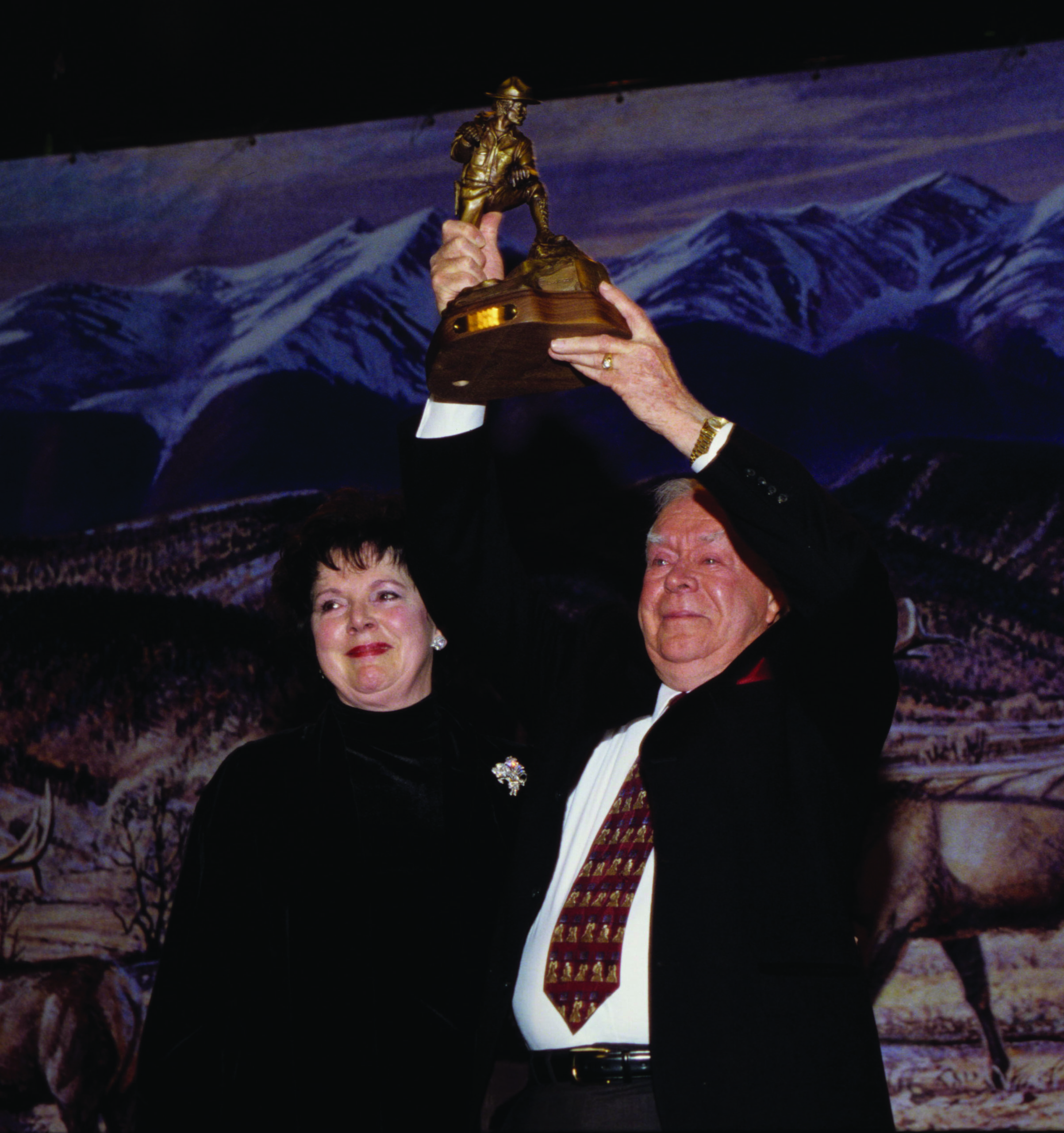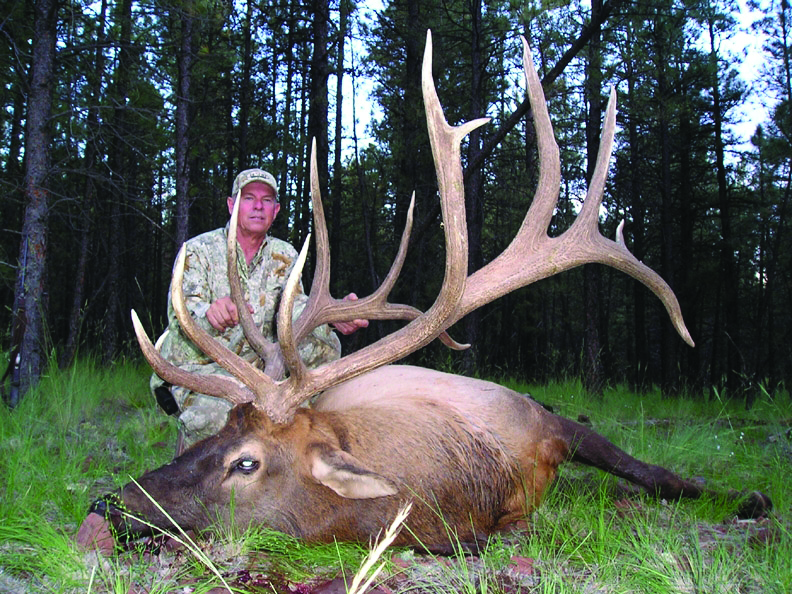“He was a self-made man and a very special guy. Whatever he did, he did it by himself. It’s quite a story.”
Below is a reprint of the Jan-Feb 2015 issue of Bugle magazine.
When you think about the key figures who helped bring the Rocky Mountain Elk Foundation to life along with its mission to ensure the future of elk and elk country, co-founders Bob Munson and Charlie Decker immediately come to mind. However, there is another early pioneer and visionary who will never be forgotten. Aaron Jones recently died at the age of 92 but his legacy and contributions to the RMEF will live on.
“Without Aaron, there’s a good possibility that we wouldn’t have made it because he stepped up to the plate several different times,” said Decker. “He was really key and critical to the start of RMEF. We had to get Bugle magazine published so we called him to borrow $10,000. He told us to pay him back in a year. But in a year, we didn’t have it. So, we went to the bank and borrowed $10,000 and sent it to him. He sent it back to us and said, ‘I was just checking you guys out.’”
That level of trust, generosity, commitment and leadership supplied much-needed stability for an RMEF seeking to establish itself in its earliest years. Jones served as RMEF’s second chair of the board, following the footsteps of his friend Wallace Pate. He went on to become an early life member and leader on the Habitat Council. In 2001, Aaron and his wife Marie jointly received the Wallace Fennell Pate Wildlife Conservation Award, RMEF’s highest honor, for contributions of lasting significance to the Elk Foundation’s mission. It was presented by their long-time friend, former Forest Service Chief and fellow elk hunter, Jack Ward Thomas, who had himself become chair of the RMEF’s board of directors.
Jones’s actions and attitude also led to the formation of a deep bond and a long-lasting kinship between himself and Decker.
“We got to be great friends. I think we took close to 20 hunting trips together,” Decker said. “He was a self-made man and a very special guy. Whatever he did, he did it by himself. It’s quite a story.”
“Self-made man” is the perfect way to describe Jones. He was born in Utopia, Texas, but his childhood was anything but utopian. He witnessed his mother’s murder before his fifth birthday and he and his brothers spent time in an orphanage. His father paid their room and board at the children’s home until his auto repair shop burned down during the depths of the Depression. With no money to have his children live in the home, Aaron’s father moved him and his brothers to an uncle’s dairy farm in Oregon when Aaron was 10. The uncle took them in, but only on the condition that they earned their keep, which meant waking before dawn to work before school, then working until dark once they got home.
Jones excelled in school, served as the president of his class and was one of only two 1940 Toledo (Oregon) High School graduates to go to college. He put his education on hold to serve in World War II, where he ran an Army supply depot in the Philippines. After the war, he returned home and eventually earned a degree in physical education from the University of Oregon.
Jones worked in the woods setting chokers for his father-in-law, took shifts in his father-in-law’s planing mill and started trying his hand at selling lumber. Before long, he learned the ins and outs of the logging industry.
In 1953, he ventured out on his own and founded Seneca Sawmill Company in Eugene, taking its name from the property he leased on Seneca Road. By the end of the first year, with 25 employees and a production of 18,000 board feet of lumber, the fledgling company had already outgrown that location. He built the business into a thriving operation that provided a quality product for clients and steady paychecks for members of the community.
A problem-solver by nature, Jones was never content to do things the way they had always been done. He kept asking questions and exploring ways to get more lumber out of each log with less waste and more efficiency. Over the years, Jones was awarded more than 25 patents for sawmill technologies, which he developed through close teamwork with his employees. Aaron was always quick to credit his workforce for his extraordinary success and was fiercely loyal to his employees, saying, “The experience, ability and dedication of our people are second to none. They are Seneca’s greatest asset.”
Seeing a need for a reliable source of timber, Aaron began buying his own timberland in 1989. Today, Seneca owns 165,000 acres. In 1994, Jones developed the “Friendly Swap,” pioneering the concept of exchanging land between the federal government and private landowners to create land ownership patterns that better supported both landscape-scale ecosystem management and timber production.
His work as a leader in the lumber industry led to his appointment to numerous boards and organizations. He also received various awards for his dedication to the land, its resources and those who worked and owned it.

“Aaron will be remembered for the way he treated people. If he believed in someone, there was no limit to his support of that person. If he believed that something was right, there was no limit to his support of that principle,” said Marie Jones, Aaron’s wife. “In the days of price controls where some lumber manufacturers would sell their lumber to a shill company of their own so it could be resold at a higher price, Aaron refused to do business that way. He said he ‘would not take a nickel that didn’t belong to me.’”
Today, Seneca has more than 400 employees working in its four sawmills. Production exceeds 650 million board feet. Seneca Sustainable Energy, which came to life in 2009, uses the mill byproducts and other woody biomass to produce renewable energy for the local community.
Outside of family and work, Jones had several other passions. One of them was the outdoors, especially in the fall.
“Hunting season was Aaron’s favorite time of the year, and it was the only time you wouldn’t find him hard at work at his desk or out in the mill,” added Marie. “He loved to talk about the hunting trophies that hung on the walls at his office and at his cabin.”
In 2003, during his last hunt, Jones earned a spot high up in the Boone & Crockett record books after he killed a massive seven-by-seven bull elk in Arizona.
Aaron and Marie also loved to ride horses. Aaron was an excellent horseman who enjoyed trips to eastern Oregon, where he could be seen racing over rough ground at breakneck speed, rounding up wild horses with Basque shepherders. Their shared passion for horses and Thoroughbred racing developed into a thriving second business raising and breeding horses. Their best finish in the Kentucky Derby was fourth, but one of their horses won the Preakness, a horse sired by one of their stallions won the Belmont Stakes, and their horses also won several Breeders’ Cup races. The successful operation breeding championship Thoroughbreds continues today in Kentucky.
Jones is perhaps best known for having a big heart. His philanthropic endeavors were many. In addition to his financial support of RMEF, he also gave generously to the Festival of Trees, Volunteers in Medicine and Marist High School as well as the University of Oregon’s athletic program and business school. He was a proud father, grandfather and great-grandfather who loved children and inspired those around him with his integrity and honesty.
As the bulls bugled all across elk country, Jones died on September 22, 2014, his favorite time of year. He is survived by his wife, three daughters, one stepdaughter, six grandchildren, five great-grandchildren and a national conservation organization that reveres his name and lasting legacy.
